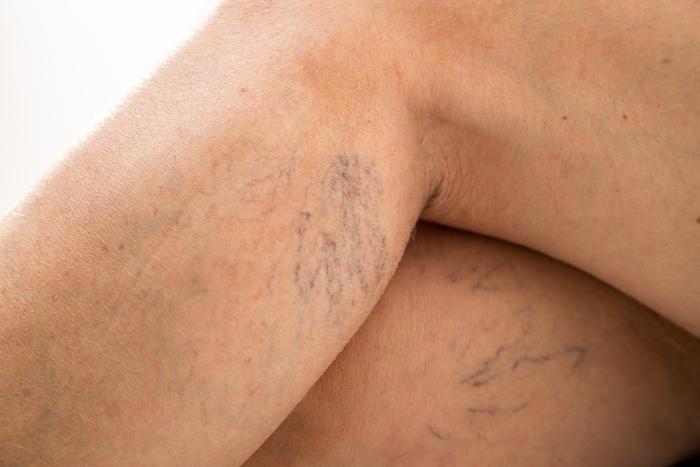Have you also developed spider veins recently and want to know whether they are dangerous or not? Are you also concerned about your condition due to rumors about it? Well, worry no more, then.
Spider veins are not dangerous. Although it is a medical issue and can cause problems in your life, it is not life-threatening. But if it is an early symptom of any other medical condition, like CVI, then you should take it seriously. From common symptoms to severe complications and treatments, here we will discuss everything about this condition in detail.
You should be paying attention to what we are saying in this article. Do not go away, until you have finished all the important information explained to you.
What Are Spider Veins?
Spider veins are small, dilated blood vessels near the surface of the skin. These are also known as telangiectasia, or thread veins. You can notice them on your skin as thin, red, blue, or purple lines or web-like patterns. These may also be similar, like spider webs or tree branches. These can occur anywhere on the body, but they usually occur on the legs and face.
When the walls of the veins in your body are not strong, then they become damaged. There are other reasons as well that are responsible for the issues behind spider veins. Sometimes, parents of some children experience spider veins. Now, children inherit these traits and get more chances of developing them. As we enter into the age of puberty, changes happen in our hormones, which can be the cause of developing spider veins.
People experiencing obesity must reduce their weight. They are likely to develop spider veins because their obese weight puts extra pressure on the veins. Many people perform the occupations of security guards that require standing for a long time. They are more prone to developing spider veins. Pregnancy is also the cause of developing them, which goes away after birth of a child.
Symptoms Of Spider Veins
Following are the common symptoms associated with spider veins: If most of these sound familiar, then you are probably right and are affected by this condition. These signs and symptoms include:
- Visible veins
- Red or blue veins
- Vein clusters
- Swelling
- Achiness
- Throbbing
- Heaviness in the legs
- Itching around veins
- Burning sensation
- Discomfort after prolonged standing or sitting
Are Spider Veins Dangerous?
No, spider veins are not dangerous. This is a common medical problem and is not life-threatening or very serious. This condition simply means that some of your blood vessels are damaged. It’s more about the look of your skin than the discomfort.
If it has occurred due to some simple blood vessels, then you don’t need to worry. But sometimes it could also be a symptom of chronic venous insufficiency (CVI). In this condition, it could be serious because it could lead to further complications.
What Are The Complications Of Spider Veins?
Spider veins are generally not considered a serious medical condition and rarely lead to complications. But in some cases, like CVI, these may also cause certain complications, like cellulitis or venous stasis ulcers. The best way is to consult your doctor and diagnose the cause first. It will keep you on the safer side and avoid any potential complications.
Spider Vein Treatments
There are multiple treatment options for spider veins. These vary depending on their size, location, and severity. Your doctor will suggest the best one for you according to your diagnosis. Here are some common treatments:
- Sclerotherapy: The first on our list is sclerotherapy. It is the most common treatment for spider veins. It involves injecting a solution directly into the affected veins. This solution collapses them, and then they fade away. You may also need multiple sessions to get results from this method.
- Laser Therapy: The second option is laser treatment. It involves focused light energy to heat and destroy the spider veins. This method is often recommended for smaller veins, which are very close to the skin’s surface. It is a safe treatment option and doesn’t hurt your skin.
- Intense Pulsed Light (IPL) Therapy: The next spider vein treatment is IPL therapy. This treatment method involves broad-spectrum light to target spider veins. It is somewhat similar to laser therapy.
- Vein Ablation: It takes us to our next treatment method, vein ablation. It is often recommended for larger spider veins or underlying venous insufficiencies. You may be recommended for endovenous laser ablation (EVLA) or radiofrequency ablation (RFA). These procedures involve the use of heat energy to treat the affected veins.
- Ambulatory Phlebectomy: Ambulatory phlebectomy is the next one on our list. It is a surgical procedure that involves removing small sections of spider veins through tiny incisions in the skin. It is often recommended as an alternative for larger or more stubborn veins.
These were all the treatment options. Moreover, making lifestyle modifications such as maintaining a healthy weight, exercising regularly, and avoiding prolonged periods of standing or sitting can also help. It may also be recommended to use compression stockings for this purpose as well.
Final Words
Spider veins are not usually dangerous, but in some cases, they may get serious. It usually happens when it is not the only issue, and there are other medical conditions associated with this condition as well.
You should recognize the symptoms of this condition well for an early diagnosis. It will help you quickly get rid of this condition. Keep visiting us for more health- and fitness-related issues.


